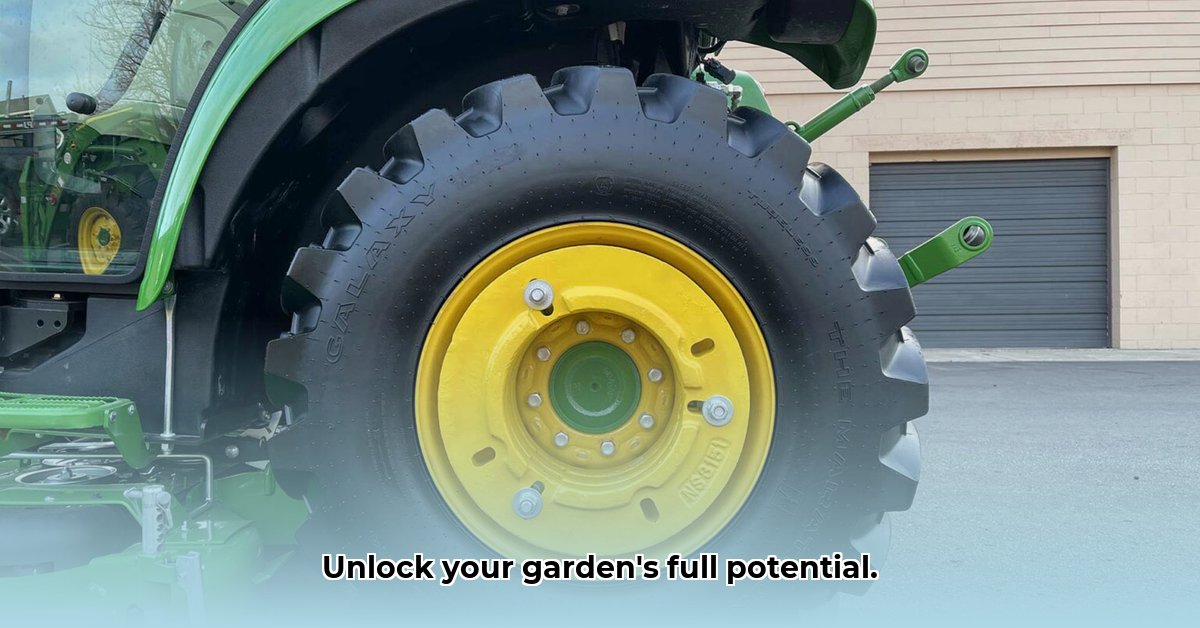
Adding weight to your John Deere garden tractor isn't just about raw power; it's about optimizing performance and protecting your soil – a critical aspect of sustainable gardening. Proper weight distribution enhances traction, stability, and fuel efficiency, minimizing soil compaction and promoting a healthier garden ecosystem. This guide will walk you through selecting, installing, and maintaining weights for your John Deere garden tractor. For more information on John Deere attachments, check out this helpful resource: John Deere Attachments.
Types of Weights for Your John Deere Garden Tractor
Several weight types enhance your John Deere's capabilities for various tasks. Choosing the right type maximizes efficiency and minimizes soil compaction.
Rear Weights: These cast-iron blocks attach to your tractor's rear, providing significant traction for plowing, tilling, and other heavy-duty operations. They increase the downward force, preventing wheel spin on challenging terrains.
Front Weights: Mounted on the front, these weights enhance stability, especially when using front-mounted implements like snow blowers or cultivators. They prevent tipping, particularly on slopes or uneven surfaces.
Wheel Weights: These fill with liquid (often antifreeze, providing both weight and freeze protection) or solid materials and clamp directly onto your wheels. They offer superior traction enhancement by directly increasing the weight at the point of contact with the ground.
Always consult your John Deere owner's manual for weight capacity limits specific to your tractor model. Exceeding these limits can damage your tractor and compromise safety.
Determining the Correct Weight for Your Gardening Tasks
Selecting the appropriate weight involves considering several factors to achieve optimal performance without causing unnecessary soil compaction or damaging your equipment.
Assess the Task: Mowing a lawn requires significantly less weight than tilling heavy clay soil. Heavy-duty tasks demand more weight to prevent slippage and maintain traction.
Analyze Soil Conditions: Heavy clay soils require more weight than lighter, sandy soils to prevent wheel spin and ensure proper implement penetration.
Consider Your Implements: Heavier implements, like tillers, necessitate more counterweight than lighter ones, such as lawn mowers. The weight of the implement itself influences the amount of additional weight you'll need.
Check Your Owner's Manual: Your owner's manual provides specific weight recommendations based on your tractor model and intended tasks. This is crucial for safe and effective operation.
Weight Recommendation Guidelines (Approximate – Always Refer to Your Manual):
| Task | Soil Type | Weight Recommendation (lbs) | Notes |
|---|---|---|---|
| Mowing | Sandy | 50-100 | Sufficient for most level terrain |
| Mowing | Clay | 100-150 | Prevents slippage on heavier, more resistant soils |
| Tilling | Sandy | 100-200 | Adequate for lighter soils |
| Tilling | Clay | 200-300 | May require more for deep tilling |
| Light Plowing | Sandy | 150-200 | Depends on plow type and soil conditions |
| Heavy Plowing | Clay | 250+ | Requires substantial weight for deep plowing |
Safely Installing and Removing Your Tractor Weights
Proper installation and removal of weights are crucial for safety and preventing damage to your tractor.
Preparation: Ensure your tractor is level, the parking brake is firmly engaged, and the engine is turned off before handling weights.
Lifting and Positioning: Use appropriate lifting tools; never manually lift heavy weights. Carefully align weights with their designated mounting points.
Secure Fastening: Use the correct pins, bolts, or other fasteners specified in your owner's manual. Ensure all connections are tight and secure before operating the tractor.
Removal: Carefully reverse the installation process. Proceed slowly and meticulously to prevent injury or damage.
Maintaining and Storing Weights for Long-Term Use
Proper maintenance extends the lifespan of your tractor weights.
Cleaning: After each use, clean weights to remove dirt and debris, preventing rust and corrosion.
Storage: Store weights in a dry, sheltered location, preferably indoors or under a cover, to protect them from the elements.
Troubleshooting Common Weight-Related Issues
Excessive Wheel Slippage: Indicates insufficient weight. Gradually add more weight until traction improves.
Overstressed Tractor: If the tractor feels strained, reduce the weight. It's preferable to have slightly less weight and maintain control than risk damage.
Vibrations: Uneven weight distribution often causes vibrations. Recheck weight placement to ensure balance.
Sustainable Gardening Practices Through Weight Management
Proper weight management contributes significantly to sustainable gardening practices.
Reduced Soil Compaction: Correct weight distribution prevents excessive soil compression, preserving soil structure and promoting healthy water and nutrient penetration.
Improved Fuel Efficiency: Optimal weight enhances traction, reducing engine strain and fuel consumption.
Minimizing Passes: Efficient weight use allows for fewer passes over the same area, minimizing soil disturbance and fuel usage.
By carefully selecting and managing your tractor weights, you promote a more efficient and environmentally responsible gardening approach. Always prioritize safety and refer to your John Deere owner's manual for specific guidance.